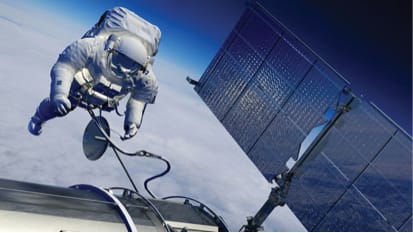3-D Printers take off!
Osama Awara, new tech editor, informs you about 3D space printing!

Launching a rocket into space is in itself a tricky business; well after all it is rocket science! Being able to repair one or a space station for that matter is a different ball game altogether. NASA has plans to launch their very own 3-D printer by next year, and for those of you who aren’t familiar with this novel way of printing, it basically involves making a 3-D object of your choice and having a machine spew it out for you by simply adding layers of material together. NASA has been looking at ways for many years to make the lives of astronauts easier, as if having to chase their food around isn’t trouble enough, astronauts have to worry about repairing faulty components in and around space craft/stations which can potentially be life threatening if not attended to. A perfect example of this was in 1970 when astronauts abroad the fatally struck Apollo 13 were forced to jerry rig a carbon-dioxide filter using scrap materials such as a plastic bag and book cover and the old classic of DIY: duct tape. If it were not for the ingenuity of crew members and engineers on ground control, this could’ve potentially been a disastrous return mission. What NASA aims to do with 3-D printing is allow astronauts to build their own repair tools and replacement parts so incidents that happened back in the old ’70s NASA era aren’t repeated. “Imagine an astronaut needing to make a life-or-death repair… Rather than hoping that the necessary parts and tools are on the station already, what if the parts could be 3-D printed when they needed them?” Aaron Kemmer, CEO of Made in Space, a company which is one of Silicon Valley’s new members and are contracted to oversee NASA’s 3-D printing space programme (pretty impressive for a start-up to say the least). Now of course it’s not just space safety that 3-D printers will improve but also making the availability of space (if you’d pardon the pun) a hell of a lot better. Imagine eventually being able to launch a printer into space that allows you to make virtually anything, all you’d need to take up with you is just the printer and some plastic, obviously I’m exaggerating a wee bit but you get my point, 3-D printers will make sending a rocket into space a lot less heavier which for NASA is a big bonus because fuel prices just aren’t in the favour of anyone these days, apart from them Saudi oil lords. Scott Crump, one of the first developers of 3-D printing said, ‘The good news is that you don’t have to have this huge amount of inventory in space, but the bad news is now you need materials,’ and I get his point: you’ will need to be able to store large quantities of different types of material (namely plastic and metal) but at the end of the day storing them is a lot easier and convenient then storing already built and functioning equipment. What is more amazing than printing tools and parts, is miniature 3-D satellites, ‘what!?’ I hear you shout, yes, NASA engineers are also trying their hands at 3-D printing these little bad-boys that could shoot out of the space station and transmit signals to earth. Of course space printers are going to have to be made slightly different from their earthly counterparts as they’d have to operate under zero gravity and survive the ridiculous amount of vibrations during take-off in order to land in one piece, so in terms of cost it’d be more than your average $2000 3-D printer but knowing NASA’s outrageous budgets investing in one of these would be like us going into a supermarket and buying a kilo of tomatoes. All in all for any remaining sceptics out there, 3-D printing is a sustainable method for bringing with you what you need when you need it.









